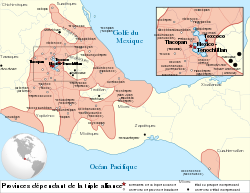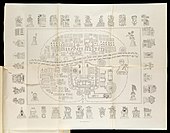Tlaxcala (Nahua state)
Confederacy of Tlaxcala Tlahtōlōyān Tlaxcallan(Classical Nahuatl) | |||||||||||||||
|---|---|---|---|---|---|---|---|---|---|---|---|---|---|---|---|
| 1348–1520 | |||||||||||||||
Battle vexilloid worn by Tlaxcalan warriors who fought alongside the Spanish (Lienzo de Tlaxcala)
| |||||||||||||||
 Tlaxcala was surrounded by the Aztec Empire in 1519. | |||||||||||||||
| Capital | Tlaxcala | ||||||||||||||
| Common languages | Nahuatl(Official) | ||||||||||||||
| Religion | Tlaxcaltecan religion | ||||||||||||||
| Government | Confederation | ||||||||||||||
| Tlatoani of Tlaxcala | |||||||||||||||
• 1348 | Culhuatecuhtli | ||||||||||||||
| Historical era | Post Classic/Early Modern | ||||||||||||||
• The Tlaxcalla People Migrate to Central Mexico | 1348 | ||||||||||||||
| 1520 | |||||||||||||||
| Population | |||||||||||||||
• 1348 | ? | ||||||||||||||
• early 15th century | 650,000 | ||||||||||||||
• 1519 | 300,000 | ||||||||||||||
| Currency | Quachtli,Cacao | ||||||||||||||
| |||||||||||||||
| Today part of | Tlaxcala, Mexico | ||||||||||||||
Tlaxcala(Classical Nahuatl:Tlaxcallān[tɬaʃ.ˈká.lːaːn̥]'place of maize tortillas') was apre-Columbiancity and state in centralMexico.
During theSpanish conquest of the Aztec Empire,theTlaxcaltecsallied with theSpanish Empireagainst their hated enemies, theAztecs,supplying a large contingent for and sometimes most of the Spanish-led army that eventually destroyed theAztec Empire.
Tlaxcala was completely surrounded by Aztec lands, leading to the intermittent so called "flower war"between theAztecsand the Tlaxcalans, fighting for their independence, as the Aztecs wanted to absorb them into the empire.
History
[edit]
The top-right hand sector isTizatlan,bottom-rightQuiahuiztlan,top-leftOcotelolco,and bottom-leftTepeticpac.The riverAtzompacrosses the city from north to south (left to right, the map being oriented east–west). FromAlfredo Chavero,Pinturas Jeroglíficas,Mexico 1901.

The Tlaxcalans arrived in Central Mexico during theLate Postclassic.They first settled nearTexcocoin thevalley of Mexico,between the settlement of Cohuatlinchan and the shore ofLake Texcoco.[1]After some years the Tlaxcallans were driven out of the valley of Mexico and moved to the east, splitting into three groups along the way. While one group continued north towards the modern state ofHidalgoand another remained in the vicinity of Texcoco, a third group arrived in the modern valley of Tlaxcala, where they established the city ofTepetícpac Texcallanunder the leadership ofCulhuatecuhtli Quanex.
Over the subsequent years, the Tlaxcallan state expanded with the foundations ofOcotelulcoandTizatlán.The fourth major settlement,Quiahuiztlan,was founded by members of the Tlaxcallan group that had initially remained in the valley of Mexico.[1]
| Tepeticpac | Ocotelolco | Tizatlan | Quiahuiztlan |
|---|---|---|---|
| Señor de Aztahua de Tizatlan | |||
| Cuitlixcatl | Xayacamach | ||
| Tlahuexolotzin | Maxixcatl | Xicotencatl I | Citlapopocaizin |
| Lorenzo Maxixcatl |
Government
[edit]Ancient Tlaxcala was arepublicruled by a council of between 50 and 200 chief political officials (teuctli [sg.], teteuctin [pl.]).[2][3][4]These officials gained their positions through service to the state, usually in warfare, and as a result came from both the noble (pilli) and commoner (macehualli)classes.
Contact with conquistadors
[edit]Tlaxcala was never conquered by the Aztec empire, but was engaged in a state of perpetual war, the so-calledflower warsor garland wars.
ConquistadorBernal Díaz del Castillodescribes the first battle between the Spanish force and the Tlaxcalteca as surprisingly difficult. He writes that they probably would not have survived, had notXicotencatl the Elder,andMaxixcatzin,persuadedXicotencatl the Younger– the Tlaxcallan warleader – that it would be better to ally with the newcomers than to kill them.[5]: 140–188
Xicohtencatl the Younger was later condemned by the Tlaxcaltecan ruling council and hanged byCortésfor desertion in April 1521 during thesiege of Tenochtitlan.
Due to protracted warfare between the Aztecs and the Tlaxcala, the Tlaxcala were eager to exact revenge, and soon became loyal allies of the Spanish. Even after the Spanish were expelled fromTenochtitlan,the Tlaxcala continued to support their conquest. Tlaxcala also assisted the Spanish in theconquest of Guatemala.[6]
As a result of their alliance with the Spaniards, Tlaxcala hadhidalgoprivileged status within Spanish colonial Mexico as confirmed in theRoyal Writ of the Foundation of the City of Tlaxcala, Mexico.After the Spanish conquered Tenochtitlan and the rest of Mexico, Tlaxcala was allowed to survive and preserve its pre-Columbian culture. In addition, as a reward to the Tlaxcalans unyielding loyalty to the Spanish, the city and its inhabitants largely escaped the pillaging and destruction following the Spanish conquest. The Tlaxcalans gave further assistance in theMixtón War.

Following the Spanish Conquest, Tlaxcala was divided into four fiefdoms (señoríos) by the Spanish corregidorGómez de Santillánin 1545 (26 years after the Conquest). These fiefdoms wereOcotelolco,Quiahuiztlan,Tepeticpac,andTizatlan.At this time, four great houses or lineages emerged and claimed hereditary rights to each fiefdom and created fictitious genealogies extending back into the pre-Columbian era to justify their claims.[7]
During thecolonial period,Tlaxcala's "part in the conquest of the Aztec 'empire,' her favored treatment by the Spanish crown, her unique talent for propaganda and litigation, her astonishing enterprise" gave the small state an important place in Mexican history.[8]
In the 16th and 17th centuries Tlaxcala settlers went to live in new northern colonies to protect Mexico from the Chichimecas.[9]
See also
[edit]- Tlaxcaltec– Nahuatl for inhabitants of Tlaxcala
- Tlaxcala– the present dayMexican state
- Tlaxcala, Tlaxcala– the present day capital of the state of Tlaxcala
References
[edit]- ^abAurelio López Corral; et al. (2016)."La República de Tlaxcallan".Arqueología Mexicana.139:42–53.
- ^Fargher, Lane F.; Blanton, Richard E.; Espinoza, Verenice Y. Heredia (2010)."Egalitarian Ideology and Political Power in Prehispanic Central Mexico: The Case of Tlaxcallan".Latin American Antiquity.21(3): 227–251.doi:10.7183/1045-6635.21.3.227.JSTOR25766992.
- ^Graeber, David and Wengrow, David "The Dawn of Everything, A New History of Humanity" (New York: Farrar, Straus and Giroux, 2021), pp. 346–358
- ^Fargher, Lane F.; Blanton, Richard E.; Espinoza, Verenice Y. Heredia; Millhauser, John; Xiuhtecutli, Nezahualcoyotl; Overholtzer, Lisa (2011)."Tlaxcallan: The archaeology of an ancient republic in the New World".Antiquity.85(327): 172–186.doi:10.1017/S0003598X0006751X.
- ^Diaz, B., 1963, The Conquest of New Spain, London: Penguin Books,ISBN0140441239
- ^Restall and Asselbergs 2007, pp. 79–81.
- ^Gibson, 1952.
- ^Simpson, Leslie Byrd."Tlaxcala in the Sixteenth Century by Charles Gibson".JSTOR.Pacific Historical Review.JSTOR4491989.Retrieved29 September2021.
- ^Schmal, John P. (2019-09-12)."Indigenous Tlaxcala: The Allies of the Spaniards".Indigenous Mexico.Retrieved2022-12-28.
Sources
[edit]- Diego Muñoz Camargo'sHistory of Tlaxcala(Lienzo de Tlaxcala), written in or before 1585, is an illustratedcodexdescribing the conquest of Mexico. It was painted by Tlaxcalteca artists under Spanish supervision.
- Crónica Mexicayotlwas written byFernando Alvarado Tezozomoc,in Nahuatl and Spanish, in the last decades of the 16th century.
Bibliography
[edit]- Alvarado Tezozomoc, Fernando (1944).Crónica Mexicana.Mexico: Manuel Orozco y Berra, Leyenda.
- Fargher, Lane F., Richard E. Blanton and Verenice Y. Heredia Espinoza (2010). Egalitarian Ideology and Political Power in Prehispanic Central Mexico: The Case of Tlaxcallan. "Latin American Antiquity," 21(3):227–251.
- Gibson, Charles (1952).Tlaxcala in the Sixteenth Century.New Haven: Yale University Press.
- Hassig, Ross (2001)."Xicotencatl: rethinking an indigenous Mexican hero",Estudios de Cultura Nahuatl, UNAM.
- Hicks, Frederic (2009). Land and Succession in the Indigenous Noble Houses of Sixteenth-Century Tlaxcala.Ethnohistory,56:4, 569–588.
- Muñoz Camargo, Diego (1982) [1892].Historia de Tlaxcala.Alfredo Chavero. México.
- Restall, Matthew;Florine Asselbergs (2007).Invading Guatemala: Spanish, Nahua, and Maya Accounts of the Conquest Wars.University Park, Pennsylvania, USA:Pennsylvania State University Press.ISBN978-0-271-02758-6.OCLC165478850.
- Our lady of assumption ex convent.Bienvenidos al INAH. (n.d.). Retrieved November 30, 2021, from https:// inah.gob.mx/en/english/4181-our-lady-of-assumption-ex-convent.


